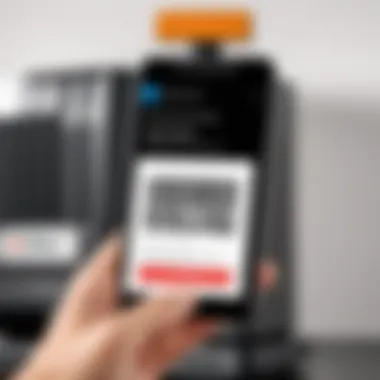Unlocking Efficiency with Zoho Inventory's Barcode Features


Intro
In today's rapidly evolving business landscape, managing inventory efficiently is of utmost importance. Businesses, regardless of size, often encounter challenges related to stock accuracy, manual errors, and time-consuming processes. Zoho Inventory, as a comprehensive inventory management solution, addresses these challenges through its advanced barcode features. This article will delve into how these features contribute to improved efficiency and productivity, ultimately leading to better business outcomes.
Software Category Overview
Purpose and Importance
The primary function of inventory management software like Zoho Inventory is to streamline inventory processes. By utilizing barcode technology, organizations are capable of enhancing the accuracy of stock tracking and minimizing human error. This technology allows for quicker check-ins and check-outs, efficient shelf management, and precise stock monitoring. As businesses seek to optimize their operations, the integration of barcode systems becomes increasingly crucial.
Current Trends in the Software Category
There is a noticeable shift towards automation in inventory management. Businesses are leveraging barcode systems not only for tracking but also for detailed data analysis. A growing number of organizations are adopting integrated systems that offer real-time tracking capability, which is essential for effective decision-making. Mobile capabilities are also on the rise, enabling staff to scan items from smartphones or tablets, further enhancing operational efficiency.
Data-Driven Analysis
Metrics and Criteria for Evaluation
To gauge the effectiveness of Zoho Inventory's barcode features, several metrics should be considered:
- Accuracy of stock levels
- Time taken for inventory check processes
- Reduction in stock discrepancies
- Increase in order fulfillment speed
- User satisfaction ratings
Comparative Data on Leading Software Solutions
When evaluating inventory management software, a comparative analysis reveals that many solutions incorporate barcode technology. For instance, while TradeGecko and Fishbowl Inventory offer robust barcode functionalities, Zoho Inventory stands out due to its user-friendly interface and seamless integration with other systems like Zoho Books.
"Implementing barcode technology can reduce errors by up to 70% in inventory management tasks."
Prelude to Zoho Inventory
Understanding the functionality of Zoho Inventory is essential not just for professionals managing stock, but for anyone interested in optimizing operational processes. Inventory management presents specific challenges, such as accuracy, efficiency, and adaptability to market demands. The inclusion of barcode features within Zoho Inventory is a significant development aimed at addressing these issues.
When companies implement a robust inventory management system, they can mitigate risks associated with stock mismanagement. This leads to improved accuracy, reduced wastage, and a more informed decision-making process. Moreover, leveraging Zoho Inventory allows businesses to seamlessly integrate their inventory tracking with other operations. Thus, it is vital to grasp how barcode functionalities can bring tangible benefits to organizations.
Overview of Zoho Inventory Software
Zoho Inventory is a cloud-based management solution designed for businesses to optimize their stock levels and streamline sales processes. The software simplifies inventory management by providing real-time insights into stock levels, sales orders, and supply chain events. Users can easily track products as they move through different stages of the supply chain.
The software comes equipped with several features, one of which is barcode functionality. Barcodes serve as unique identifiers for products, making it easier to track them throughout the management process. This element enhances operational efficiency by reducing the time spent on manual data entry and minimizing errors commonly associated with human oversight.
Aside from the barcode functions, Zoho Inventory integrates well with other Zoho solutions and third-party applications, allowing businesses to create a comprehensive operational ecosystem. This coherence contributes to its appeal within various industries, as it adapts to specific business needs, further underscoring its utility in modern inventory management.
Importance of Inventory Management
Effective inventory management plays a crucial role in the overall success of a business. It ensures that companies operate without surplus stock or stockouts, optimizing their financial resources. When done correctly, businesses can achieve higher customer satisfaction and loyalty by ensuring products are available when needed.
Key aspects of inventory management include:
- Accuracy: Maintaining precise stock levels to avoid discrepancies.
- Cost Efficiency: Reducing unnecessary holding costs associated with excess inventory.
- Demand Forecasting: Predicting future demand accurately to match stock levels accordingly.
- Supplier Relationship Management: Managing suppliers effectively to ensure timely restocking.
With proper inventory management, companies do not only enhance operational efficiency but also support strategic planning and resource allocation. Hence, combining these elements with the capabilities of Zoho Inventory, particularly its barcode features, can lead to a more streamlined approach for businesses, regardless of size.
Understanding Barcodes


Understanding the various aspects of barcodes is crucial to effectively utilizing the barcode features within Zoho Inventory. Barcodes serve as an essential tool in modern inventory management, enabling businesses to track products with greater accuracy and efficiency. This section will delve into the definition of barcodes, their functionalities, and specifically outline the different types of barcodes used in inventory management.
What Are Barcodes?
Barcodes are graphical representations of data, typically a series of parallel lines and spaces that can be scanned using a barcode reader. Each barcode corresponds to specific information about a product, such as its price, product ID, or any other data relevant to inventory management. The primary function of barcodes is to reduce human error in data entry and to speed up the process of managing inventory.
Importantly, barcodes facilitate real-time inventory updates. When a product is scanned, information enters the system immediately, allowing businesses to maintain accurate stock levels without manual entry. This automation contributes to improved operational efficiency, which is central to contemporary inventory management responsibilities.
Types of Barcodes Used in Inventory
Understanding the specific types of barcodes is vital for businesses to select the suitable system that meets their needs. Here are the main types commonly utilized in inventory management:
1D Barcodes
1D Barcodes, also known as one-dimensional codes, are the most traditional form of barcodes. These codes consist of vertical lines of varying widths and spaces. A key characteristic of one-dimensional barcodes is their simplicity, as they encode limited data—typically just a numerical value.
Their popularity in inventory systems comes from their ease of scanning and the low cost of implementation. Retail environments often use 1D barcodes for products. However, a limitation is their capacity; since they hold a minimal amount of information, they may not suffice for more complex inventory needs.
2D Barcodes
2D Barcodes provide a more advanced option compared to their 1D counterparts. These codes can store a significantly larger amount of data, due to their square design, which allows for both horizontal and vertical scanning. A key characteristic of 2D barcodes is their ability to convey various information such as URLs, price details, and extensive product information all in one code.
In an inventory context, they improve efficiency in data collection and can lead to better stock management. However, their complexity can lead to higher costs in terms of hardware needed for scanning, which may deter smaller businesses.
QR Codes
QR Codes (Quick Response Codes) are a specific type of 2D barcode. They have gained immense popularity due to their versatility and increased data storage capabilities. Unlike traditional barcodes, QR Codes can store up to several thousand alphanumeric characters. This unique attribute of QR Codes makes them especially useful for various applications in inventory management, including linking to digital content like instructions or promotional material.
While QR Codes are highly advantageous, a potential drawback lies in the necessity for compatible scanning devices. Businesses must ensure that their equipment can read QR Codes effectively, which may require additional investment.
"Incorporating barcodes into inventory management systems streamlines operations and minimizes error, enhancing overall efficiency."
Understanding the differing types of barcodes is integral to optimizing inventory management. Each variant presents unique benefits and challenges, depending on the specific needs of a business. In subsequent sections, we will further explore how Zoho Inventory integrates these barcode technologies to enhance inventory tracking and operational efficiency.
Integration of Barcodes in Zoho Inventory
The integration of barcodes in Zoho Inventory is a crucial aspect of modern inventory management. Barcodes provide an efficient means of tracking products, reducing human error, and streamlining operational processes. The use of barcodes within Zoho Inventory aids businesses in several ways, namely by enhancing accuracy, improving speed, and enabling effective stock management.
When businesses adopt barcode technology, they can transform their inventory systems significantly. Incorporating barcodes into inventory management not only facilitates faster processing during transactions but also allows for real-time tracking of stock levels. The immediate benefit of this technology is reduced time spent on manual stock counts and entry tasks. Companies can allocate their resources more effectively and enhance their decision-making capabilities.
Setting Up Barcodes in Zoho Inventory
Setting up barcodes in Zoho Inventory is a straightforward task that catapults the functionality of the software. First, users must navigate to the inventory settings within Zoho. Here, you can enable barcode functionality. Once activated, the software provides options for generating barcodes for existing products or new items.
To set up a barcode for a product, you typically follow these steps:
- Select the Product: Choose the item that requires a barcode.
- Generate a Barcode: Use the automatic barcode generation feature within Zoho. You can also enter a custom number.
- Save Changes: Confirm the new barcode details are correctly inputted before saving.
This setup enables businesses to label their inventory in a manner that facilitates easy scanning and tracking in various environments. With Zoho Inventory's intuitive interface, users can swiftly adapt to this system, making it an accessible choice for diverse business types.
Linking Barcodes to Products
Linking barcodes to products is a pivotal step in maximizing the utility of Zoho Inventory’s features. This process involves associating specific barcodes with each product in the system. Such a connection supports efficient stock management and accurate sales tracking.


- Access the Product Catalogue: Start with the product list in Zoho Inventory.
- Locate Specific Items: Find the product that you want to link with a barcode.
- Assign the Barcode: Input the corresponding barcode in the designated field.
- Save Configuration: Make sure the updates are stored correctly in the system.
Once the barcodes are linked, every scan provides immediate visibility into inventory levels, movement status, and sales data. This linkage is critical for maintaining accurate records and enhancing overall efficiency.
By integrating barcodes effectively, businesses using Zoho Inventory can create a streamlined, highly automated inventory management system, which is essential for modern operations.
Advantages of Using Barcodes
The integration of barcodes in inventory systems offers a myriad of advantages. As businesses strive for greater efficiency, these benefits become increasingly vital. Understanding the potential of barcode technology allows for enhanced inventory management. This section will delve into three main aspects: increased accuracy in tracking inventory, enhanced speed of operations, and improved stock management.
Increased Accuracy in Inventory Tracking
Accuracy in inventory tracking is one of the most significant advantages of using barcodes. Traditional methods often rely on manual entry, which is prone to human error. Barcodes eliminate much of this risk. When a product is scanned, the system automatically retrieves the relevant data. This real-time data updating ensures that information is current and reliable.
With Zoho Inventory, each barcode corresponds to a unique product ID. This unique association enhances clarity in inventory levels. This clarity is crucial for businesses that manage a large number of items. The reduction of discrepancy in stock levels allows for a more precise understanding of available products. It can lead to minimized stockouts and overstock situations, both of which can incur additional costs.
"Barcodes help maintain data integrity by automating the inventory process, reducing errors and improving reliability in stock levels."
Enhanced Speed of Operations
Speed is essential in today’s fast-paced business environment. Barcodes provide a clear advantage in streamlining operations. Scanning a barcode takes considerably less time than manual entry. Employees can quickly locate items, process transactions, and perform stock checks. This efficiency reduces the time spent on inventory tasks. In turn, it allows staff to focus on other critical aspects of the business.
In Zoho Inventory, the integration of barcode scanning features supports rapid stocktaking. Whether it is receiving new shipments or conducting periodic stock audits, barcodes facilitate swift operations. As a result, businesses can respond quickly to customer needs, improving overall service delivery. Enhanced speed can ultimately lead to higher customer satisfaction, reinforcing customer loyalty.
Improved Stock Management
Effective stock management is essential for maintaining a healthy inventory. Barcodes play a key role in providing detailed insights into stock levels. With the ability to track individual items, businesses can implement just-in-time inventory practices. This means they can keep only the necessary amount of stock on hand. Reducing excess inventory reduces storage costs and minimizes waste.
Moreover, the ability to monitor product performance is increased with barcodes. By integrating barcode data into Zoho Inventory, businesses can analyze sales trends accurately. This analysis helps in making informed decisions regarding reordering products and discontinuing others. Improved stock management translates into a stronger bottom line.
In summary, barcodes significantly enhance the efficiency of inventory tracking, boost operational speed, and improve overall stock management. Businesses that adopt these technologies are likely to see substantial improvements in their operations.
Challenges in Implementing Barcode Systems
Implementing a barcode system in Zoho Inventory can offer various advantages, but it is crucial to recognize and address the challenges that come with it. Understanding these challenges helps businesses prepare better, ensuring a smoother integration process and maximizing the benefits of barcode technology. The concerns can generally be categorized into setup costs and the need for staff training. Both of these aspects are vital in determining how effective the implementation will be and how quickly the advantages can be realized.
Initial Setup Costs
Setting up a barcode system involves several expenses that can accumulate quickly. Organizations may incur costs related to:
- Hardware purchases: Barcode scanners, printers, and mobile devices are typically needed for efficient operations. Selecting the right equipment from brands like Zebra or Honeywell can impact initial outlay significantly.
- Software licensing and subscription fees: Depending on the scale of the operations and the features utilized, costs associated with Zoho Inventory's subscription may vary. It's essential to evaluate the different plans available to find the most cost-effective choice.
- Integration expenses: Implementing a barcode system may also require integration efforts, which can involve additional fees if third-party services are needed or if in-house IT resources are inadequate.
While these costs can be daunting, it is important to evaluate them against the long-term benefits. Improved accuracy, enhanced efficiency, and reduced labor costs often justify the initial investments.
Training Staff on Barcode Usage
One of the more critical challenges organizations face is adequately training staff on how to use the new barcode system effectively. This includes:
- Familiarization with equipment: Employees must learn to use barcode scanners and printers if they are not familiar with such technologies. Hands-on training workshops can significantly enhance their confidence and ability to execute tasks correctly.
- Understanding software functionalities: Staff should also be trained on how to navigate Zoho Inventory and its barcode features. Without proper training, they might struggle with day-to-day tasks, leading to delays and potential errors in inventory management.
- Creating a culture of technology adoption: Companies must help employees accept and embrace the change. Ongoing support and clear communication regarding the system's benefits can foster better adoption.
Overall, investing in training can enhance productivity and achieve a smoother transition to a barcode system, which ultimately leads to stronger inventory management.
Best Practices for Managing Barcodes in Zoho Inventory


Managing barcodes effectively is crucial to optimize the use of Zoho Inventory. Businesses can significantly enhance their inventory management practices when they follow certain best practices. These practices ensure the integrity of data related to stock levels and products, resulting in streamlined operations and reduced errors.
Regular Audits for Barcode Accuracy
Regular audits are one of the most important practices for ensuring the accuracy of barcode data. This involves reviewing and verifying the barcodes assigned to each product against the actual inventory on hand. By conducting frequent audits, businesses can identify discrepancies early and take corrective action.
Auditing helps maintain the accuracy of stock levels, which is critical for decision-making. When barcodes match the physical stock, it reduces the risk of stockouts and overstocking, which can incur unnecessary costs. To implement a successful audit process, consider the following:
- Schedule audits periodically, such as weekly or monthly, based on the size and complexity of your inventory.
- Use mobile devices or barcode scanners that integrate with Zoho Inventory to quickly verify barcode information.
- Document findings and take immediate action to address any discrepancies.
Implementing regular audits instills a sense of reliability in inventory data, which is vital for any business.
Consistent Updates to Product Information
Maintaining accurate product information is essential in connection with barcode management. Inventory data can change due to various factors such as new products being added, changes in pricing, or modifications in product specifications. Consistent updates ensure that the barcodes accurately reflect current information in the inventory system.
When product information becomes outdated, this can lead to errors during scanning and tracking, ultimately affecting operations. To efficiently manage updates, businesses should:
- Establish a standardized process for updating product information right after changes occur, such as adding new items or altering prices.
- Train staff on the importance of updating information and the process to follow for changes.
- Utilize Zoho Inventory prompts or notifications to remind staff to check and update relevant information regularly.
By ensuring that product data is consistently updated, organizations can keep their barcode systems accurate, thus maximizing operational efficiency.
Future Trends in Barcode Technologies
The evolution of barcode technology is essential in the context of modern inventory management. As businesses seek ways to enhance operational efficiency, the future of barcode systems presents several opportunities and challenges. Understanding these trends can help organizations effectively adopt innovative practices that optimize inventory control and resource management. The focus on advancements in scanning technology and integration with mobile devices signifies a shift towards greater accessibility and agility in inventory processes.
Advancements in Scanning Technology
Scanning technology is undergoing rapid advancements, which in turn transforms how businesses manage their inventory. Several key developments are shaping this domain:
- Increased Speed and Accuracy: New scanning devices have emerged that can read multiple barcodes simultaneously. This advancement reduces the time employees spend on inventory tasks, ensuring a fast and accurate tracking process.
- Enhanced Data Processing: Modern scanners not only read barcodes but also process data in real time. This capability enables businesses to access up-to-date information regarding stock levels and movements immediately, contributing to informed decision-making.
- Artificial Intelligence Integration: The incorporation of AI in scanning technologies allows for better inventory predictions and trends analysis. This technology can identify patterns that human operators might miss, thus optimizing inventory levels and reducing stockouts.
"The future of barcode scanning is promising, with technology enabling unprecedented speed and accuracy in inventory management."
Integration with Mobile Devices
Mobile technology is significantly impacting how businesses utilize barcode systems. The integration of barcode reading capabilities into mobile devices brings several advantages:
- Mobility and Flexibility: Employees can perform inventory management tasks from anywhere within the facility, increasing operational efficiency.
- Cost Efficiency: Utilizing existing mobile devices eliminates the need to purchase specialized equipment. This can lead to significant cost savings for businesses, especially smaller ones.
- User-Friendly Interfaces: Many mobile applications designed for barcode scanning offer intuitive interfaces. This further streamlines the training process for staff, making it easier to adopt new technologies swiftly.
- Real-Time Data Updates: With mobile integration, changes in inventory can be updated and accessed instantly, helping to prevent data discrepancies.
In summary, the future trends in barcode technologies hold the potential to revolutionize inventory management. By focusing on advancements in scanning technology and the integration of mobile devices, businesses can enhance their operational capabilities, embrace efficiency, and drive better outcomes.
The End
In concluding this exploration of barcode functionality within Zoho Inventory, it is crucial to underscore the manifold benefits and implications that emerge from effective barcode implementation in inventory management. Businesses today, across various sectors, increasingly recognize the necessity of efficient inventory systems. The integration of barcodes not only streamlines processes but also significantly enhances accuracy in tracking stock levels and locations.
Summarizing the Benefits of Barcodes in Inventory Management
Barcodes serve as the backbone of modern inventory management systems. The prominent advantages include:
- Increased Accuracy: Barcodes minimize human error associated with manual entry tasks. Scanning items leads to precise tracking, resulting in fewer mismatches and discrepancies in inventory data.
- Speed of Operations: Quick scanning allows employees to process inventory items swiftly. This speed is essential during busy periods, reducing wait times and improving overall workflow.
- Cost Efficiency: Over time, the reduced labor costs and enhanced accuracy lead to significant savings. Fewer errors also mean less money spent rectifying issues, providing substantial financial benefits to organizations.
- Better Resource Management: With improved visibility of stock levels, businesses can optimize inventory turnover. This agile management aids in minimizing holding costs and prevents stockouts.
These components work together, creating a robust inventory ecosystem that supports business growth.
The Role of Zoho Inventory in Modern Business Practices
Zoho Inventory embodies the integration of advanced technology into everyday business practices. Its barcode features create a sophisticated yet user-friendly interface, catering to a diverse range of industries. Points of importance include:
- User-Centric Design: The interface is intuitive, allowing even non-technical staff to utilize the barcode system effectively. This user-friendliness ensures a smooth transition and encourages adoption among team members.
- Adaptability: Zoho Inventory supports multi-channel retailing, accommodating various sales platforms from a single solution. Barcode functionalities support this flexibility, allowing businesses to track inventory from sales made online or in physical stores.
- Real-Time Data Access: The ability to scan barcodes provides real-time updates on inventory levels. This immediate information empowers managers to make informed decisions about purchasing and stock replenishment.
In a rapidly evolving business landscape, the role of Zoho Inventory, supplemented by barcode technology, becomes increasingly critical. The combination fosters efficiency and competitiveness, ensuring that businesses are well-positioned to navigate future challenges in inventory management.







